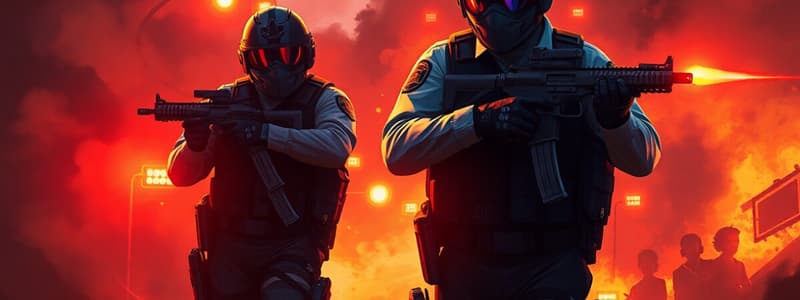Podcast
Questions and Answers
What defines an active killer according to the Miami Police Department's procedures?
What defines an active killer according to the Miami Police Department's procedures?
- Anyone involved in a crime that results in fatalities but not using a weapon.
- A person who acts in coordination with law enforcement during emergencies.
- Anyone who uses a weapon to inflict death or serious injury while continuing unrestricted access to victims. (correct)
- An individual who acts alone to inflict harm and escapes unnoticed.
What is the main purpose of the Miami Police Department's standard operating procedures for rapid response to an active killer?
What is the main purpose of the Miami Police Department's standard operating procedures for rapid response to an active killer?
- To prepare officers for managing traffic during emergencies.
- To establish protocols for high-speed chases.
- To provide guidelines for crowd control in public events.
- To ensure the resolution of an active killer incident and the safety of the public and officers. (correct)
What is the role of the Ambulance Exchange Point (AEP) in active killer incidents?
What is the role of the Ambulance Exchange Point (AEP) in active killer incidents?
- A site for press briefings in the event of a crisis.
- A designated spot for ambulance pickups of casualties from the Warm Zone. (correct)
- A location to stage police tactical units.
- An area for administrative meetings during emergencies.
In what configuration must Miami police officers be prepared to operate during an active killer incident?
In what configuration must Miami police officers be prepared to operate during an active killer incident?
Which characteristic is NOT required for the location of an Ambulance Exchange Point?
Which characteristic is NOT required for the location of an Ambulance Exchange Point?
What is the primary purpose of a casualty collection point (CCP)?
What is the primary purpose of a casualty collection point (CCP)?
Which zone is defined as an area where no significant danger can be anticipated?
Which zone is defined as an area where no significant danger can be anticipated?
What is the role of a contact team during an active incident?
What is the role of a contact team during an active incident?
How does cover differ from concealment in a tactical environment?
How does cover differ from concealment in a tactical environment?
What is meant by the term 'force protection' in a law enforcement context?
What is meant by the term 'force protection' in a law enforcement context?
What is the primary responsibility of the Incident Commander (IC)?
What is the primary responsibility of the Incident Commander (IC)?
What is the purpose of the Safety Cordon?
What is the purpose of the Safety Cordon?
Which statement best describes the Incident Command System (ICS)?
Which statement best describes the Incident Command System (ICS)?
What is the maximum number of officers that can be part of a Rescue Task Force (RTF)?
What is the maximum number of officers that can be part of a Rescue Task Force (RTF)?
Why is maintaining an effective span of control important in emergency response incidents?
Why is maintaining an effective span of control important in emergency response incidents?
What is the primary objective of police response in an active killer incident?
What is the primary objective of police response in an active killer incident?
Who holds the role of the initial Incident Commander during the first response to an active killer incident?
Who holds the role of the initial Incident Commander during the first response to an active killer incident?
Which of the following should NOT be part of the initial 'size up report' provided by the Incident Commander?
Which of the following should NOT be part of the initial 'size up report' provided by the Incident Commander?
What is indicated as a driving force for a solo entry into an active killer incident?
What is indicated as a driving force for a solo entry into an active killer incident?
What should officers consider regarding vehicle location before arriving at an active killer incident?
What should officers consider regarding vehicle location before arriving at an active killer incident?
What equipment is essential for police officers responding to an active killer incident?
What equipment is essential for police officers responding to an active killer incident?
In the context of incident command, what does 'I AM IN COMMAND' signify?
In the context of incident command, what does 'I AM IN COMMAND' signify?
What does the unified command system apply to?
What does the unified command system apply to?
What is the primary responsibility of the front cover position in a two-man movement?
What is the primary responsibility of the front cover position in a two-man movement?
Which principle should a team follow when moving through a structure?
Which principle should a team follow when moving through a structure?
When is stealth movement primarily utilized by officers?
When is stealth movement primarily utilized by officers?
In a three-man team movement, what roles do the team members play?
In a three-man team movement, what roles do the team members play?
What should the Incident Commander (IC) do as additional officers arrive on scene?
What should the Incident Commander (IC) do as additional officers arrive on scene?
What is a critical aspect of a four-man team movement formation?
What is a critical aspect of a four-man team movement formation?
Which of the following statements about contact teams is inaccurate?
Which of the following statements about contact teams is inaccurate?
Flashcards are hidden until you start studying
Study Notes
Overview of SOP 2-15
- The Miami Police Department (MPD) emphasizes the importance of effective preparation for active killer incidents to ensure public and officer safety.
- Officers must work in a Unified Command configuration with other agencies for multi-agency responses.
Definitions and Concepts
- Active Killer: Individual using weapons to cause mass death or serious injury.
- Ambulance Exchange Point (AEP): Location for ambulances to collect casualties, requires accessibility and defensible positioning.
- Casualty Collection Point (CCP): Designated area for wounded individuals to receive medical attention, must be safe and accessible.
Zones in Incident Response
- Cold Zone: Safe area with no anticipated threats; used for staging resources and managing treatment and transportation.
- Warm Zone: Area of minimal threat where responders can assist victims.
- Hot Zone: Direct threat area where immediate action against an active killer is required.
Safety and Equipment Guidelines
- Ballistic Protective Equipment: Includes body armor and shields to protect responding officers.
- Cover vs. Concealment: Cover protects against ballistic threats; concealment hides but does not protect.
Incident Command Structure
- Incident Commander (IC): Responsible for all incident activities, including strategy and resource management.
- Incident Command System (ICS): Ensures organized management of resources during emergencies across agencies.
Rescue Operations
- Rescue Task Force (RTF): Team of officers and fire rescue personnel that enters warm or cold zones to aid victims.
- Evacuation Cordon: Secured area for safe evacuation of victims.
Tactical Movement and Team Strategies
- Various formations for team movements (2-man, 3-man, etc.) ensure 360-degree security and effective coverage in potentially dangerous environments.
- Teams must evaluate threshold conditions before entry into rooms to maintain safety.
Response Execution
- First responding officer establishes initial command and conducts a situational assessment.
- Officers are trained to neutralize threats while also planning to assist and evacuate victims.
Coordination and Resource Management
- Staging Area: Location for resources awaiting tactical assignment.
- Safety Cordon: Secure area for safe passage of rescue teams.
Incident Recovery and Demobilization
- Once threats are neutralized, focus shifts to aiding casualties from the Casualty Collection Point and preserving the crime scene.
- Debriefs and consideration of responder welfare are essential post-incident.
Interagency Collaboration
- Collaborative agreement with Miami Fire Rescue to enhance operational integration during incidents with hostile elements.
Conclusion
- The procedures outlined enhance readiness for active killer situations, promoting rapid response, effective communication, and collaboration among first responders to minimize loss of life and ensure the safety of the public.
Studying That Suits You
Use AI to generate personalized quizzes and flashcards to suit your learning preferences.



